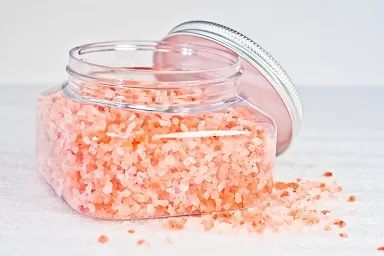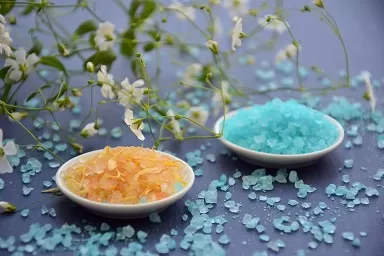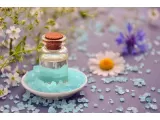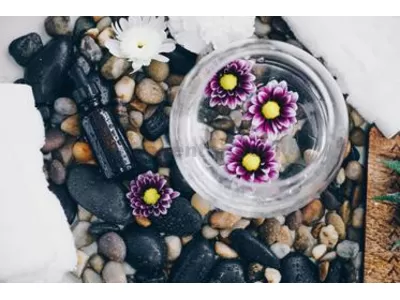$0.00
CheckoutHow to choose or make your own bath salt
On the store shelf in front of you, there is a salt “tablecloth” tablecloth - bath salts in several rows - and your eyes run up because they all look attractive, smell deliciously delicious, and the prices are not very different. How in the current variety of bath salts to choose natural, useful - and at the same time convenient to use? And is it possible to prepare such salt independently, not only to save money, but also in order to precisely control the quality of the final product?
 It is important to understand that the bath salt performs a more useful function than, for example, foam. There are many tools that tint the water, give air foam, smell good, that is, make bathing a more pleasant experience, but at the same time do not give anything to the skin or to health in general. Foam, bath "pearls", synthetic bath milk - all this at best has no effect, at worst - can dry out the skin or cause allergies.
It is important to understand that the bath salt performs a more useful function than, for example, foam. There are many tools that tint the water, give air foam, smell good, that is, make bathing a more pleasant experience, but at the same time do not give anything to the skin or to health in general. Foam, bath "pearls", synthetic bath milk - all this at best has no effect, at worst - can dry out the skin or cause allergies.
Natural sea bath salt is used not so much as a decorative tool, but for the sake of its medicinal, cosmetological properties. Sea salt is effective against edema, baths with it tone up blood circulation, work as a good lifting tool. Minerals of sea salt perfectly affect the skin, smooth it, make it more elastic, velvety. Bath with sea salt is used to treat joints, cramps, insomnia, colds. Therefore, her choice requires a more careful approach: if you already buy bath salts, buy a really good, natural one in order to get the full effect of the use of salt.
About dosage! Talking about how much salt to add to the bath, usually indicate the average dose: something about 100-200 g of salt per bath. In fact, the dosage may be completely different - and depending on the concentration of salt in the water, the effect of such a bath will vary.
- Up to 100g of salt gives the effect of relaxation and pleasant water texture. If the salt is flavored, then light aroma.
- 100-200 g of salt in the bath give an average effect: they have a rather strong effect on the skin (the effect of firmness and smoothness is noticeable), but in the treatment plan it is rather weak.
- 250-400g of salt is already the concentration that your body “feels”.
- More than 500g of salt is a serious therapeutic dose, at which salt manifests itself noticeably, can affect the condition of joints, muscles, blood vessels, etc.
Conclusion? You can use salt in almost any concentration - but the effect will be appropriate.
How to choose the right bath salt?
 Take a package of salt in your hands and carefully look into it. Firstly, it is very good if the packaging allows you to see the salt itself: visually it should be medium or large, clean, without dirt, sand, dark impurities. Secondly, translate the view on the composition indicated on the label. A good natural bath salt should contain the actual salt itself (sea, ocean, lake) and exclusively natural additives, for example, plant extracts, essential oils, crushed herbs and flowers. Some food coloring is allowed. Sometimes you can also come across something sudden, but innocent in salt: dry vegetable cream, spices, coniferous decoction, etc. If such components are natural, everything is in order.
Take a package of salt in your hands and carefully look into it. Firstly, it is very good if the packaging allows you to see the salt itself: visually it should be medium or large, clean, without dirt, sand, dark impurities. Secondly, translate the view on the composition indicated on the label. A good natural bath salt should contain the actual salt itself (sea, ocean, lake) and exclusively natural additives, for example, plant extracts, essential oils, crushed herbs and flowers. Some food coloring is allowed. Sometimes you can also come across something sudden, but innocent in salt: dry vegetable cream, spices, coniferous decoction, etc. If such components are natural, everything is in order.
So, salt with chamomile or yarrow extract, with essential oil of orange or patchouli, with rose petals - salt, which you can safely put in your basket.
And what salt is better left on the shelf?
The one that visually looks poorly (with sand, dirty, too small). The one that contains non-natural ingredients, for example, surfactants (they can be found in salt with foam), flavors, and harmful dyes. Uncertain formulations should also be suspicious: not “orange essential oil”, but “orange”.
What to do with "hybrids"?
Sometimes the bath salt appears in any unexpected tandem that can be confusing, but even here the rule is the same: look at the composition! For example, if you hold in your hands a jar of powdered milk with bath salt, and natural ingredients in the composition, then everything is fine, but if there are chemical surfactants, flavors and other, as part of the above-mentioned “salt with foam”. synthetic, then it is definitely not worth taking. The same principle applies to sizzling bath bombs: in natural versions you can find sea salt, soda, citric acid, cosmetic and essential oils, dried plants, but the composition of a non-natural bombs can resemble Mendeleev’s table and contain nothing useful. (oils, essential oils).
We make bath salt by yourself.
 Natural aromatic salt is really very easy to do on your own. To do this, you need ingredients such as sea salt (buy clean, as large as possible, the simplest and always without additives) and essential oils, also, of course, natural. Essential oils can be used both solo and in mixtures, taking into account both the “sound” of the aroma and the properties of the essential oils. For example, for a simple relaxing effect, you can take lavender, for a warming one — ginger or cinnamon, for a romantic mood — palmarosis, ylang-ylang, patchouli, for toning — orange, mandarin, mint.
Natural aromatic salt is really very easy to do on your own. To do this, you need ingredients such as sea salt (buy clean, as large as possible, the simplest and always without additives) and essential oils, also, of course, natural. Essential oils can be used both solo and in mixtures, taking into account both the “sound” of the aroma and the properties of the essential oils. For example, for a simple relaxing effect, you can take lavender, for a warming one — ginger or cinnamon, for a romantic mood — palmarosis, ylang-ylang, patchouli, for toning — orange, mandarin, mint.
Pour sea salt in a dry jar (ideally glass) with a tight-fitting lid, add essential oils to the salt in a ratio of 10-15 drops per 500g of salt. Shake the salt well with the lid closed. That's all, your aromatic salt is ready, just add it the next time in a bath with moderately warm water (40-43 degrees Celsius) and enjoy!




